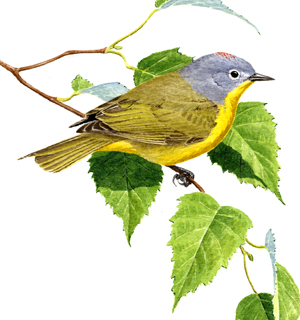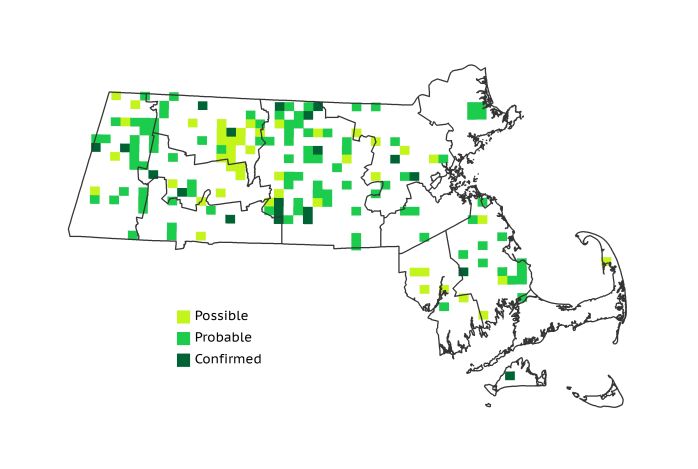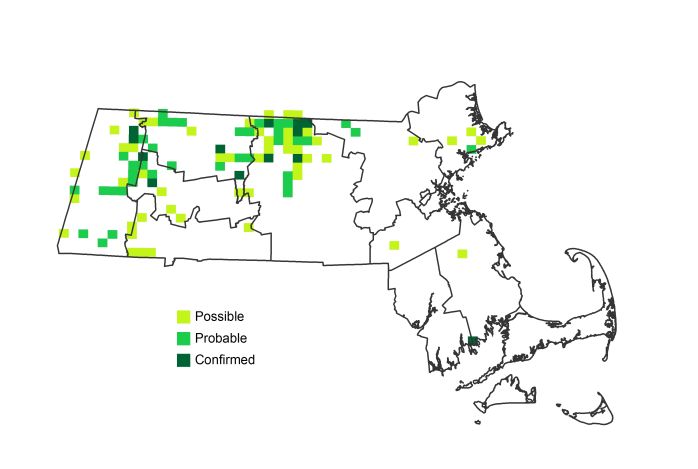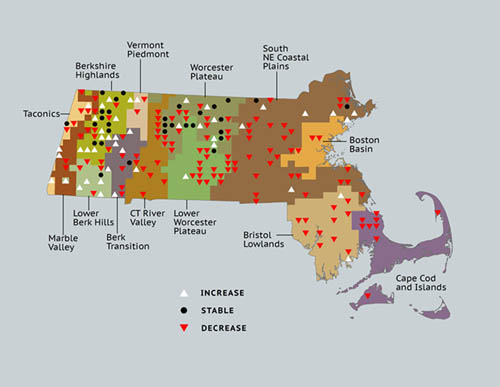Breeding Bird Atlases (BBA)
Find a Bird
Nashville Warbler
Oreothlypis ruficapilla

Local and strongly declining
Conservation action urgent
“His [Wilson’s] naming the bird for the town was natural, if inconsiderate; but it now occasions confusion and ridicule.” —Aaron Clark Bagg and Samuel Atkins Eliot, Jr., Birds of the Connecticut Valley in Massachusetts
Active pastures and fields are not attractive to the Nashville Warbler, and the species was poorly known in the Northeast throughout much of the nineteenth century. As fields were abandoned and began to grow into young forests, Nashville Warblers started to appear in greater numbers. While they probably never reached a level that could be described as “abundant,” Nashville Warblers were fairly common in areas of appropriate habitat during Atlas 1. As a lover of ephemeral shrubland habitats, and with the processes that create those habitats either suppressed or not active any longer, the fate of the Nashville Warbler seems to be that of any number of sad heroes in country music songs.
Historic Status
The Nashville Warbler was just being discovered in Massachusetts at the time that William Peabody presented his report on the birds of the state to the legislature. The species, he said, “is placed among our birds by Samuel Cabot, Jr., who obtained a specimen in Brookline,” (Peabody 1839). Three years later, Cabot shot ten more in a single morning (Bent 1953). As Massachusetts began its reforestation process, the Nashville Warbler became more common in the state both in migration and as a breeding species, preferring neither old forests nor open agricultural lands, but instead the overgrown fields that came between. By the beginning of the twentieth century, the Nashville Warbler was a common species in Massachusetts (Howe & Allen 1901).
Atlas 1 Distribution
The distribution of the Nashville Warbler in Atlas 1 was likely linked to the availability of the early successional habitat they prefer, and they were found in 17% of the blocks surveyed in Atlas 1. Each of the western regions had at least a few occupied blocks, and the Berkshire Highlands was a hot spot with the species in 17 blocks (31%) of the region. The Connecticut River Valley had relatively few, but the species’ distribution was more concentrated in the Worcester and Lower Worcester Plateau regions, where more than 30% of the species’ statewide footprint was concentrated. Nashville Warblers also had 21% of their statewide range in areas of second growth throughout the Coastal Plains, and even occupied a few blocks in the Boston Basin. The Pitch Pine and Scrub Oak-dominated forests of the Bristol/Narragansett Lowlands and the Upper Cape housed breeding Nashville Warblers, too, and Martha’s Vineyard reported a single block where breeding was Confirmed.
Atlas 2 Distribution and Change
As young forests became mature forests, Nashville Warblers found themselves with fewer and fewer places to raise a family in Massachusetts, and have been reduced to occupying only 10% of the blocks surveyed. The stronghold regions in the western part of the state suffered considerable attrition, though the Berkshire Highlands stands out as a region that gained more blocks than it lost. Occupancy dropped appreciably across the Connecticut River Valley and the Worcester Plateau regions, as well as in the Coastal Plains as mature forest or suburban sprawl reclaimed old fields. East of the Worcester Plateau, breeding Nashville Warblers were scattered and scarce. Every eastern region reported net declines in Nashville Warbler occupancy, and the species disappeared from the Boston Basin and Cape Cod completely. In fact, Nashville Warblers occupied fewer than 10 blocks east of the Route 495 corridor, where previously they had been found in nearly 40 blocks.
Atlas 1 Map

Atlas 2 Map

Atlas Change Map

Ecoregion Data
Atlas 1 | Atlas 2 | Change | ||||||
Ecoregion | # Blocks | % Blocks | % of Range | # Blocks | % Blocks | % of Range | Change in # Blocks | Change in % Blocks |
Taconic Mountains | 5 | 31.3 | 3.0 | 4 | 16.0 | 3.9 | -2 | -13.3 |
Marble Valleys/Housatonic Valley | 7 | 17.9 | 4.3 | 2 | 5.1 | 2.0 | -5 | -12.8 |
Berkshire Highlands | 17 | 30.9 | 10.4 | 23 | 41.8 | 22.5 | 5 | 9.4 |
Lower Berkshire Hills | 5 | 17.9 | 3.0 | 7 | 22.6 | 6.9 | 1 | 3.7 |
Vermont Piedmont | 3 | 17.6 | 1.8 | 2 | 11.8 | 2.0 | -1 | -8.3 |
Berkshire Transition | 7 | 18.4 | 4.3 | 7 | 17.5 | 6.9 | 0 | 0.0 |
Connecticut River Valley | 10 | 17.9 | 6.1 | 1 | 1.5 | 1.0 | -9 | -18.8 |
Worcester Plateau | 32 | 41.0 | 19.5 | 37 | 42.0 | 36.3 | -11 | -22.9 |
Lower Worcester Plateau | 21 | 28.4 | 12.8 | 8 | 10.0 | 7.8 | -13 | -24.1 |
S. New England Coastal Plains and Hills | 34 | 12.6 | 20.7 | 9 | 3.2 | 8.8 | -23 | -10.2 |
Boston Basin | 3 | 5.4 | 1.8 | 0 | 0.0 | 0.0 | -3 | -5.5 |
Bristol and Narragansett Lowlands | 11 | 10.4 | 6.7 | 2 | 1.8 | 2.0 | -9 | -8.9 |
Cape Cod and Islands | 9 | 6.6 | 5.5 | 0 | 0.0 | 0.0 | -9 | -7.5 |
Statewide Total | 164 | 16.9 | 100.0 | 102 | 9.8 | 100.0 | -79 | -9.5 |
Notes
The Nashville Warbler shows a significant decreasing Breeding Bird Survey trend in Massachusetts and in the New England/Mid-Atlantic Region.



